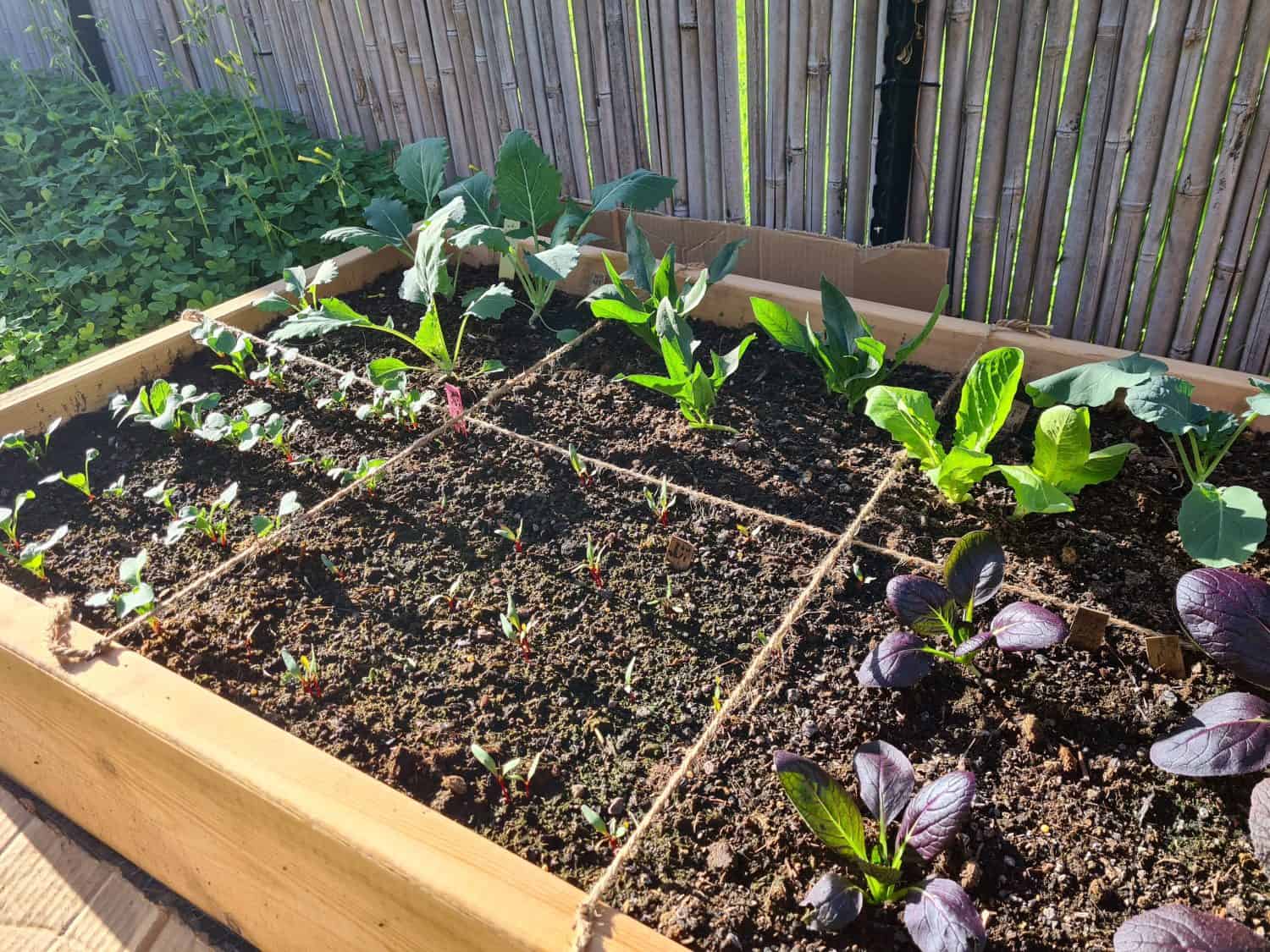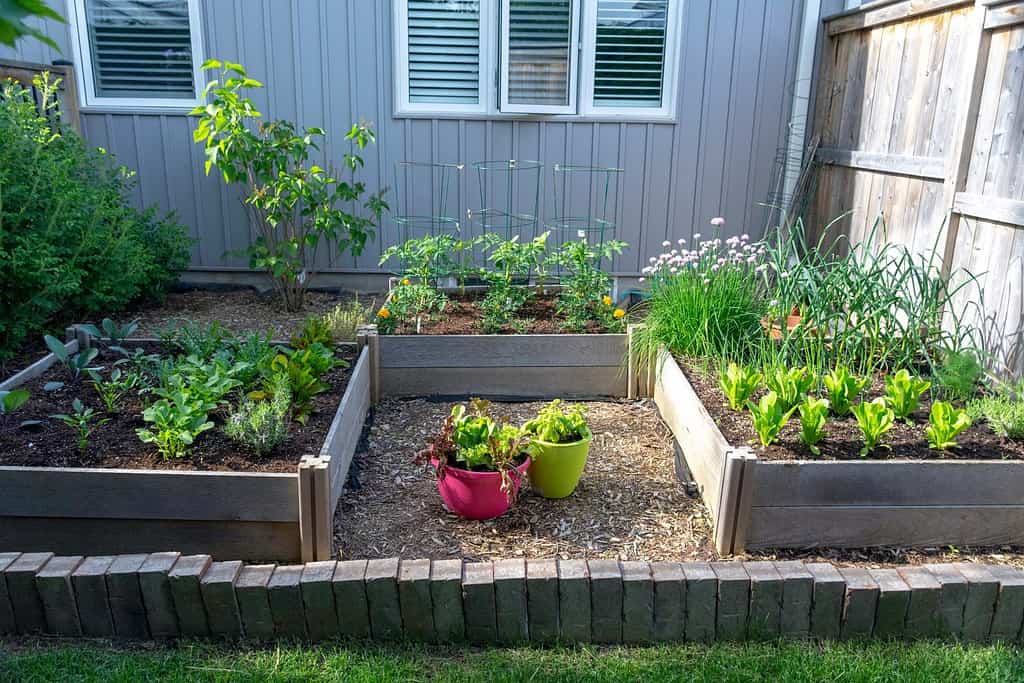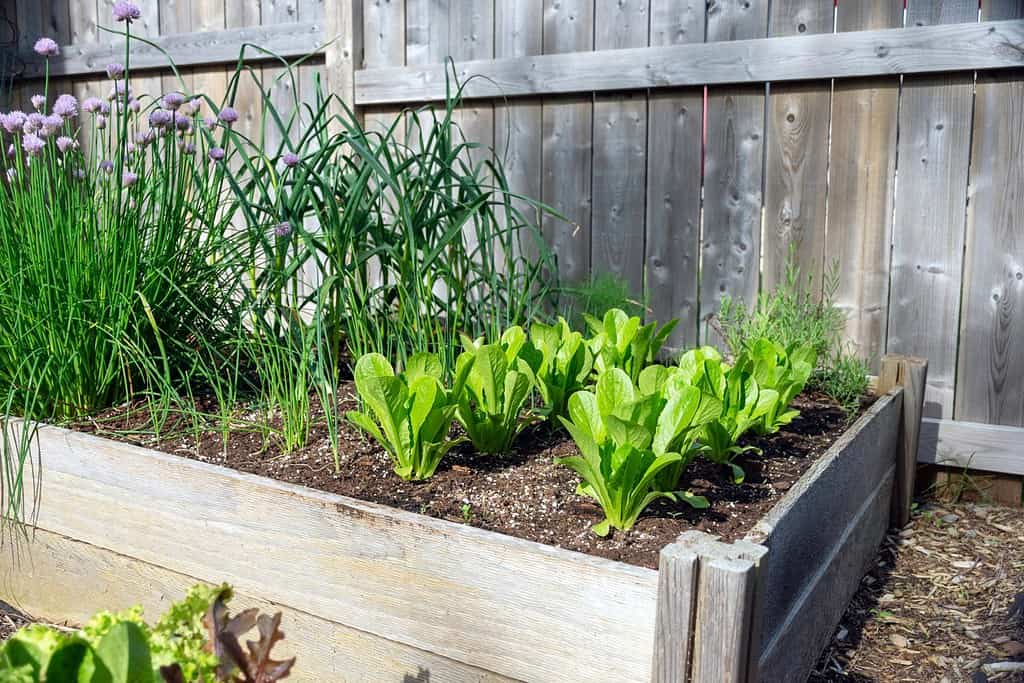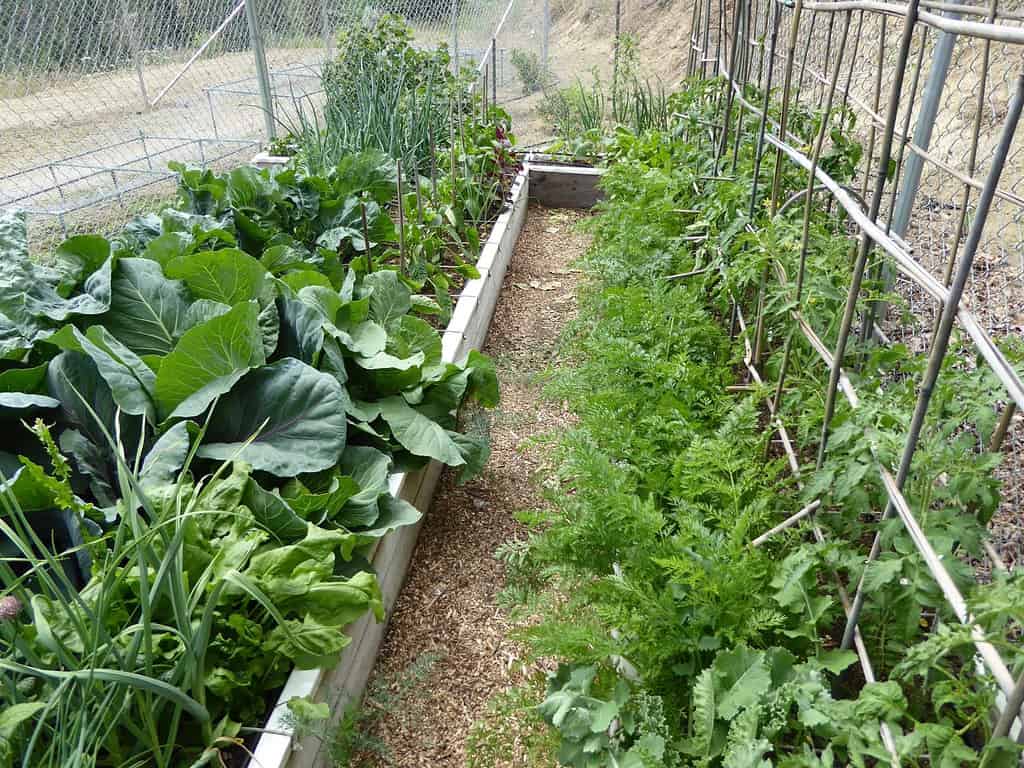
If you have limited space, try your hand at square foot gardening.
©Nura M/Shutterstock.com
Square foot gardening may sound rather technical. However, it’s actually an easy gardening method to help you make the most out of a limited amount of space. After the initial building and planning phase, you will have far less work than with a traditional garden. You’ll even get the same amount of produce, even with less space.
About Square Foot Gardening
Square foot gardening is a method of gardening that produces far less waste and requires less care than traditional row gardening methods. You don’t have to be an expert in gardening or have a green thumb to be able to grow plants with this method.
The founder of square foot gardening came up with the idea because he wanted to help people all across the world produce their own food and end world hunger. He wanted everyone to have one of these gardens in their yard. This means that the design had to be easy to make, simple to maintain, and not take up much space at the basic level. He managed to meet all of these requirements with square foot gardening.
The method involves taking a raised bed and breaking it up into square foot sections. Depending on your preferences, every square foot holds different plants so that you can get a variety food in a relatively small space. One 4-foot by 4-foot bed can provide you with four different vegetables or herbs.
It’s said that if you do it right, you grow 100 percent of the crops you want in roughly 20 percent of the space compared to row gardening in the ground.
Who Does Square Foot Gardening Work Best For?
The beauty of square foot gardening is that it works for almost anyone. Except for commercial farmers, any gardener will be able to adapt this method to fit their needs best. Make it as large or small as you want. There’s also a wide range of plants that grow in this type of garden, so you’re able to grow what you want and what you’ll actually eat.
It’s low maintenance enough that it even allows schools, children, and the elderly to have a garden without demanding too much attention throughout the day. The only people this won’t work for are people that don’t have yards at all. In that case, container gardening may work best, as it fits indoors, on porches, or balconies.
How to Square Foot Garden

Go as crazy or simple as you want with a square foot garden.
©Joanne Dale/Shutterstock.com
It’s rather easy to try out the square foot gardening method. This is one of the major reasons why it has grown so popular over the years.
All you need to do is make a square raised bed or buy one. The standard size is 4-foot by 4-foot. However, it doesn’t matter much the size so long as it breaks down into squares. Once you finish the bed, fill it up with soil, and start planning.
The planning is the hardest part of square foot gardening. You can’t just plant rows of plants and know they will work out. It’s important to know how many plants go into each section of the bed. Understanding which plants work well together will also help your garden. Take time to research companion plants to see the ones you want to grow together. This isn’t a necessity, but it does allow for a better yield.
Some plants help each other produce better or keep off pests. Other plants may inhibit each other’s growth and produce yield. This is why it’s important to make sure you understand the relationships between plants before you start your garden.
Experiment
You can experiment around with your favorite plants to see what works for you. If you’re unsure, go with some tried and true methods. For beginners, breaking the raised bed into four equal sections is probably the best method.
You aren’t only limited to one bed either. You can have as many as you want. Mix and grow all of your favorite plants and vegetables.
The most important thing you want to keep in mind is the depth of the bed. You want to stay somewhere between 6 and 12 inches deep for the best yield. In between these depths allows for your plants to get all the nutrients they need and have plenty of space for their roots, while also allowing for proper water drainage.
The Different Square Foot Gardening Methods
Though you can do any size square, the most common, and most efficient size is a 4-foot by 4-foot bed. This bed is then broken down into further squares. As the name of this gardening method suggests, one foot squares are generally the best option.
While 4 feet by 4 feet is the most common size, you can do any size combination. Generally, you want to stick with even numbers to make even, easy squares. In truth, the beds don’t even have to be square, as long as they can break down into even squares about a foot in length and width.
Some other sizes that people choose are 4 feet by 12 feet, or even smaller such as 2 feet by 2 feet. If you have an area in your yard that stretches out long but narrow, or an area you want to put a bed that’s too small to hold a 4-foot by 4-foot bed, you can mess around and find a size that works best for you.
To make sure that you have your sections right, you can stretch a string or a lattice across the top. It won’t disturb the plants, and it lets you make sure your plants aren’t spreading to where they aren’t supposed to go, and that every plant is getting the same size.
Each size of plant determines how many of the same type of plant you can put in one square. For example, in one square foot section, you can grow 16 radishes or a single cabbage. Each section offers space for 1, 2, 4, 8, 9, or 16 plants, depending on the size of the plants and the size of your squares.
Pros and Cons of Square Foot Gardening

It’s possible to have almost any mix of plants you want in your garden when you use the square foot method.
©Joanne Dale/Shutterstock.com
Square foot gardening is amazing, but it isn’t perfect. If you want to fully make sure that square foot gardening is perfect for you, then you may want to look at some of the pros and cons of this gardening method.
Pros
The pros mostly center around the fact that it’s an easy and adjustable gardening method.
- There is less waste compared to traditional row gardening
- There are fewer weeds, which means it takes less time daily to care for
- It’s easy, which makes it great for beginner gardeners
- The raised beds make it easy for the elderly and children to work in the garden
- The method produces more food in less space, which is great for those with a small yard
- It still works in community gardens
- You can adjust the size of the beds to fit your needs, and almost any plants can grow in these beds
Cons
There are some downsides you need to consider before jumping into square foot gardening.
- It’s not a good method for larger plants
- The soil mixtures recommended often contain non-renewable resources that could be harmful to the environment
- Planning out the beds, especially the first time, can take a lot of time and be intimidating
- If not planned out well, plants may end up producing less than traditional row methods
- It can be expensive to set up the first year
History of Square Foot Gardening

Your beds will be packed with your favorite fruits and vegetables.
©IsaNeu/Shutterstock.com
Square foot gardening has been around for a while. However, it started to gain popularity in 1981. This is when Mel Bartholomew promoted the method in his book and a PBS show.
Helping Others
Bartholomew’s goal was to end world hunger by teaching everyone a way they could produce their own food, even with a limited amount of space. It also eliminated a lot of the waste and effort that came with doing more traditional row gardening.
Even now, his foundation, the Square Foot Gardening Foundation created in 1996, is working to make life easier for many. The foundation is working to educate people all over the world on this gardening method to ensure that anyone can make their own food. He is certain that it is a step towards ending world hunger.
Breaking Tradition
When he asked gardeners why they did more laborious and wasteful row gardening, he received no answer other than that was the way it was always done. Bartholomew wasn’t satisfied with that answer. He set out to change the game.
Bartholomew was a retired engineer and efficiency expert who decided to put his skills into gardening. He developed the square foot gardening box that became the standard later on. At first, many expert gardeners dismissed the idea because it seemed too simple to be effective.
However, after beginner gardeners and a few from other skill levels gave it a try, there was no doubt that the method worked well. The idea that was dismissed as too simple was easy enough for beginners to pick up without a problem.
He combined the ideas of companion planting and raised bed gardening, along with a little bit of the French intensive gardening method. Then, he improved upon the idea, testing it out until he found the plants and sizes that provided the best results.
Continuous improvements
In 2006, Mel Bartholomew updated his square foot gardening method. He found that an even mix of peat moss or coconut coir, vermiculite, and compost in the beds provided the best results for plant growth.
Not only did it work with a thinner bed (6 inches), but it also kept the soil aerated, almost entirely weed-free, and eliminated the need for extra fertilizers as the compost should have all the nutrients you need.
Plants That Do Well With the Square Foot Gardening Method
Most vegetables, and many fruits, do well with the square foot gardening method. However, to get the most yield and ensure your plants have room to breathe, you need to understand how much space your plants need.
With some plants, you can only fit one plant in every square foot, while others do fine being cramped so there are sixteen per square foot.
1 Plant Per Square Foot
Larger plants need the whole square foot for themselves. Some examples of plants you need to make sure have plenty of space are tomatoes of any variety, potatoes, okra, corn, celery, and cabbage.
2 Plants Per Square Foot
The two-plants-per-square-foot option isn’t one widely used. Ones that can fit two per square foot are usually given a whole square foot just so they can be sure they have enough space.
However, if you’re trying to get as much produce in a limited space as you can get, some plants will handle the cramped area a bit better than others. Brussels sprouts, watermelons, winter squash, and cauliflower are some examples.
4 Plants Per Square Foot
When you plant four plants per square foot, you’ll place them near the corners of the square. You don’t want them right on the edge, or else they won’t have room to grow out, but closer to the corners than the center is best.
Plants that do well taking up the corner of a square foot include a lot of herbs, such as basil. Leeks, lettuce, and onions are other examples.
9 Plants Per Square Foot
Depending on how you want to break up the square, you can choose to do eight or nine plants per square foot. Just make sure they are spaced equally from each other to give them all plenty of room to grow.
Some plants that do well in groups of eight or nine are beets, garlic, and green beans.
16 Plants Per Square Foot
Carrots, parsnips, and radishes are plants that don’t mind sharing the limited space with 15 of the other same plants.
Plants That Don’t Do Well With the Square Foot Gardening Method
Most perennial plants don’t do well with the square foot gardening method. Some examples of perennial plants to avoid include artichokes, asparagus, and rhubarb.
Another reason they don’t do well is that they grow rather big, and they will overshadow some of the other plants in the area quickly. Another problem is that perennial plants don’t usually produce much in the first year. By planting them in a raised, you take up valuable space that could be used to produce food for that year.
You also want to stay away from exceptionally large plants. Shrubs and trees aren’t a good idea as they will take up too much space. Raised beds should be saved for plants that don’t take up much space and can be grown close to one another without feeling cramped.
Some people prefer to keep tall plants like corn out of raised beds as well. They can grow fine in a raised garden bed. However, they can get so tall that it’s hard to reach the top of the plant when they’re already raised off of the ground in a raised bed. This is more of a preference than a requirement, however.
Thank you for reading! Have some feedback for us? Contact the AZ Animals editorial team.








